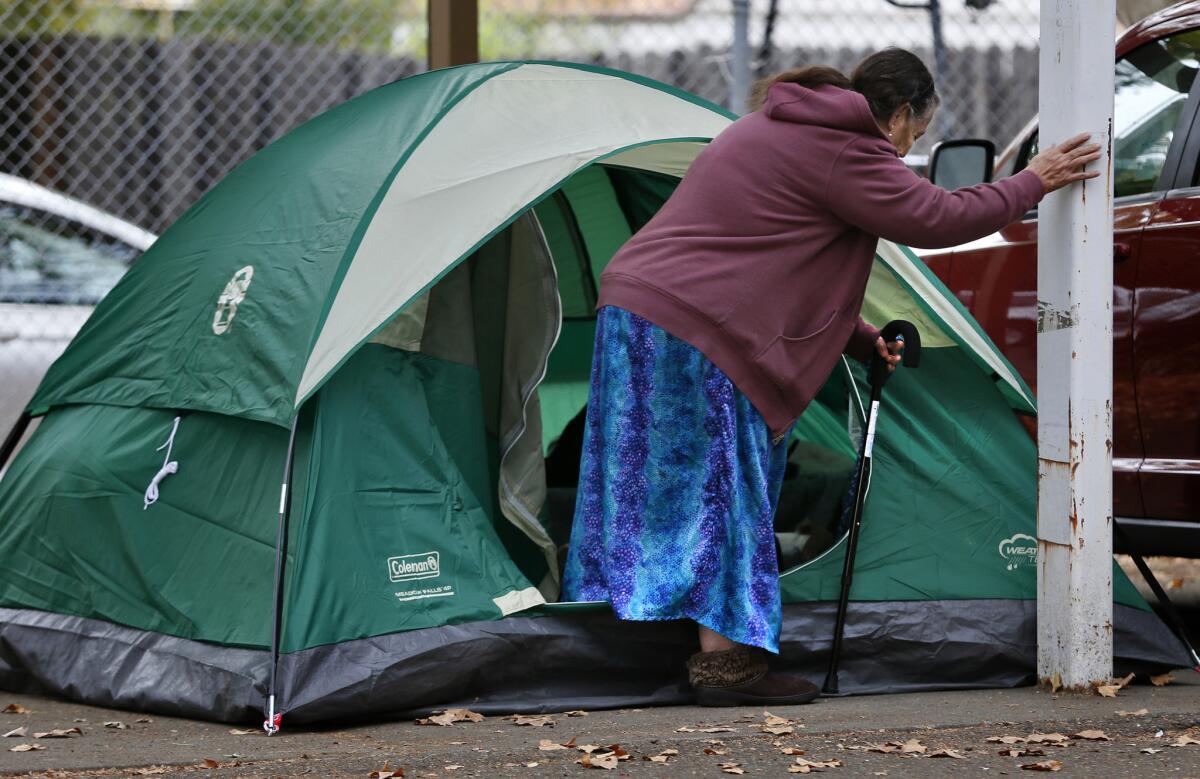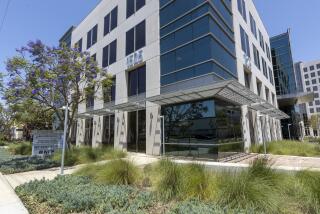California disaster planning continues to forget people with disabilities, audit finds

- Share via
California emergency officials are continuing to overlook the state’s most vulnerable people, including those with disabilities, as they make preparations for inevitable wildfires, floods and other disasters, according to a state audit released this month.
Residents who don’t speak English have been unable to find information in their language. Individuals who use wheelchairs or rely on electricity to power lifesaving equipment have found themselves unable to move and cut off from the outside world, trapped in part, the audit suggests, by state and county leaders’ inability to think ahead for emergencies.
The 145-page audit focused on the emergency alert, evacuation and shelter plans in place for the California Office of Emergency Services and Ventura, Sonoma and Butte counties ahead of their respective wildfire disasters in 2017 and 2018.
“Given the weaknesses we identified in the three counties’ plans and the struggles local jurisdictions have had in assisting people with these needs,” the audit said, “the state must take a more active role in ensuring that local jurisdictions maintain effective plans for responding to natural disasters.”
All three counties were found wanting, but the audit paid particular attention to California emergency services because of the office’s role in disseminating information downstream to counties and cities.
On that front, the state is not doing enough to protect its most vulnerable, the audit found.
“Although Cal OES has issued some guidance and tools for assisting local jurisdictions in developing emergency plans to meet access and functional needs, it has not done enough to fulfill its mission with respect to protecting these vulnerable populations,” the audit stated. “Specifically, Cal OES has not taken key steps to provide support to local jurisdictions.”
In general terms, support from the state to local jurisdictions takes the form of guidance before a disaster and then on-the-ground resources, if needed, during one. If there’s enough planning before a disaster occurs, the logic goes, there will be less stress on resources when it eventually unfolds.
But history has shown that California’s counties are not up to the task of preparing for disasters by themselves and that a standardized approach is needed. When plans fail, the most vulnerable citizens bear the brunt.
In last year’s Camp fire in and around Paradise, the overwhelming majority of the 86 people killed were senior citizens. The audit noted that people with certain access and functional needs are two to four times more likely to die as a result of a natural disaster, according to the United Nations.
So far, the audit suggests, vulnerable communities — such as non-English speakers or individuals with physical limitations — are being treated as an afterthought.
“I don’t think it’s any sort of nefarious plan, I think it is more implicit bias and not including vulnerable communities in the process,” said Belén Lopez-Grady, housing protection and policy analyst for the North Bay Organizing Project in Sonoma County, a grass-roots group with the mission of empowering marginalized communities. Disasters, she said, are exacerbating the hardship of people who “already were bearing the brunt of inequality.”
The audit pointed out that since 2013, Cal OES has been expected to update its State Emergency Plan to detail how local governments and nongovernment agencies should mobilize and evacuate people with disabilities or other access and functional needs. Those steps, or “best practices,” according to experts, should include advising counties on identifying and locating their vulnerable citizens before a disaster occurs, so precious minutes aren’t spent doing that during the emergency.
Instead, the audit said, Cal OES merely advised counties on how to mobilize their vulnerable residents without explicit guidance on locating and counting those residents beforehand. The guidance was also posted on the Cal OES website, but the state never notified anyone it was there.
The audit also faulted Cal OES for not doing more to help cities develop disaster registries of vulnerable residents, a recommendation that dates back 30 years. California’s three biggest utilities work off similar lists when shutting off power in order to ensure that those who need power keep it.
The audit’s findings weren’t a surprise to representatives from these vulnerable communities or one of the agency’s former employees.
“Cal OES has reduced itself to a low-performing paper mill, lining its shelves with ‘guidance’ documents but avoiding any attempt to improve the realities on the ground,” said Art Botterell, the agency’s former emergency services coordinator who retired in 2018. “How Cal OES addresses local emergency management practices reflects its leadership’s attitudes about the public they claim to serve.”
Defending itself, Cal OES argued that its State Emergency Plan is broad enough to cover all hazards and all people, so individuals with access and functional needs don’t require a specific carve-out.
“Rather, it addresses [vulnerable citizens] throughout the entirety of the document,” the agency said.
To underscore how seriously Cal OES considers vulnerable communities in its plans, officials pointed out that in 2008 — a year after deadly wildfires ravaged Southern California — it created the Office of Access and Functional Needs “to identify and integrate whole community needs before, during and after disasters.” The head of that office was also assigned his own support staff, Cal OES pointed out.
The problem, according to the audit, is that the state is relying on the person who leads the Office of Access and Functional Needs to represent all vulnerable communities on six of the seven state committees that handle emergency guidance. No matter how good that representative is at their job, they “cannot provide the same depth of insight” on specific needs as individuals with those actual needs, the audit stated.
“It’s really a very involved process when we pay attention to people with disabilities. It’s not a one-size-fits-all disability,” said Lillibeth Navarro, executive director of Communities Actively Living Independent & Free, a network of independent living centers serving people with disabilities in Los Angeles County. “Self-sufficiency is fine; I think it should be the norm for everybody. But we need a helping hand in terms of planning preparedness from the government side.”
Cal State Northridge professor Flavia Fleischer, chair of the university’s department of deaf studies, agreed with Navarro’s view.
“If we had the opportunity to provide input and if our input was readily incorporated, the communications issues … could be avoided,” she said.
The audit also criticized the state’s approach to multilingual messaging.
In January, a state law took effect requiring Cal OES to develop emergency guidance and notification templates in the state’s two most commonly spoken non-English languages: Spanish and Chinese, including Mandarin and Cantonese. The state finished translating messages into Spanish in September and released messages in 17 other languages in October.
The problem? It did not include an English translation for those messages, so county workers had no way of interpreting what the 17 messages said if they didn’t already speak those languages. To boot, the messages were highly specific, and the state did not provide translations for words such as “wildfire” or “earthquake” that could be put into templates for other kinds of scenarios.
Though the audit focused on three counties’ and the state’s approaches to emergencies, failing to consider vulnerable communities is a national and global problem, said Richard Skaff, executive director of Designing Accessible Communities. He became paralyzed in 1978 when a branch he was standing on while trimming a tree snapped and he fell to the ground. His first big action toward promoting inclusion was pushing for access for disabled riders of public transportation in San Francisco in 1987.
“I’ve spent the last 40 years trying to figure this out, and I’m probably going to die before I get an answer,” said Skaff, 75. “I don’t know what the answer is, and I’m sad about this. It shouldn’t have been this hard.”
More to Read
Sign up for Essential California
The most important California stories and recommendations in your inbox every morning.
You may occasionally receive promotional content from the Los Angeles Times.











